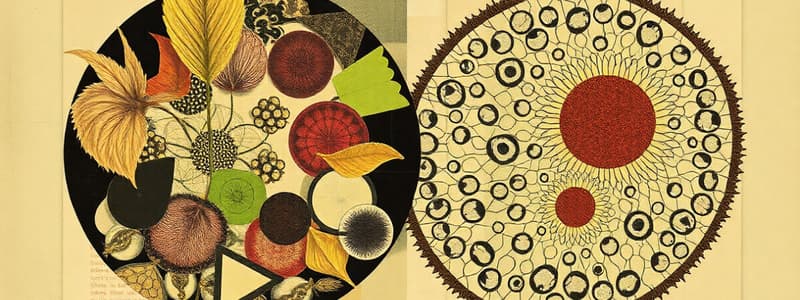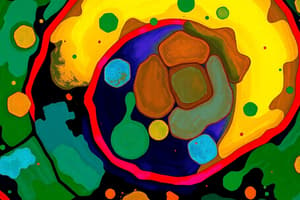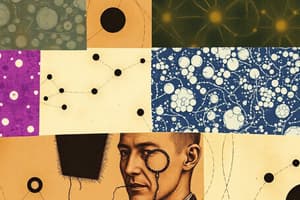Podcast
Questions and Answers
What is the function of mitochondria in a cell?
What is the function of mitochondria in a cell?
- Break down waste
- Package materials
- Produce proteins
- Convert food into energy (correct)
Which structure is exclusive to animal cells?
Which structure is exclusive to animal cells?
- Chloroplast
- Lysosome (correct)
- Vacuole
- Cell wall
What type of organism consists of only one cell?
What type of organism consists of only one cell?
- Microscopic organism
- Aquatic organism
- Multicellular organism
- Unicellular organism (correct)
What is the role of ribosomes in a cell?
What is the role of ribosomes in a cell?
Which organelle is responsible for transporting and packaging materials within a cell?
Which organelle is responsible for transporting and packaging materials within a cell?
Which of the following is a characteristic of multicellular organisms?
Which of the following is a characteristic of multicellular organisms?
What component of the cell contains the genetic blueprint?
What component of the cell contains the genetic blueprint?
How do prokaryotic cells differ from eukaryotic cells?
How do prokaryotic cells differ from eukaryotic cells?
What is the primary function of the Xylem in the plant transport system?
What is the primary function of the Xylem in the plant transport system?
What role do alveoli play in the respiratory system?
What role do alveoli play in the respiratory system?
Which type of muscle is responsible for involuntary actions such as digestion?
Which type of muscle is responsible for involuntary actions such as digestion?
Which of the following describes a force?
Which of the following describes a force?
What components make up the nervous system?
What components make up the nervous system?
Which system is primarily involved in the exchange of oxygen and carbon dioxide?
Which system is primarily involved in the exchange of oxygen and carbon dioxide?
How does the heart contribute to the circulatory system?
How does the heart contribute to the circulatory system?
What role does the skeletal system play in the body?
What role does the skeletal system play in the body?
What is the essence of the first law of motion?
What is the essence of the first law of motion?
What does the second law of motion imply about acceleration?
What does the second law of motion imply about acceleration?
What is the primary function of the Phloem in plants?
What is the primary function of the Phloem in plants?
What is potential energy?
What is potential energy?
How do reflex reactions occur according to the nervous system?
How do reflex reactions occur according to the nervous system?
Which is not a component of the muscular system?
Which is not a component of the muscular system?
What is the function of capillaries in the circulatory system?
What is the function of capillaries in the circulatory system?
Which force is considered a non-contact force?
Which force is considered a non-contact force?
Flashcards are hidden until you start studying
Study Notes
Cells
- Building blocks of life surrounded by a membrane
- Contain structures with specific functions:
- Nucleus: control center housing DNA (genetic blueprint)
- Mitochondria: powerhouses converting food into energy
- Ribosomes: produce proteins essential for cellular functions
- Endoplasmic reticulum: transports and packages materials
- Golgi apparatus: packages and processes proteins
- Lysosomes: break down waste
- Classified into prokaryotic (simpler, no nucleus) and eukaryotic (more complex, with nucleus and membrane-bound organelles)
- Perform vital functions like growth, repair, energy production, reproduction, communication, and defense, essential for all life on Earth.
Comparing Animal and Plant Cells
- Only Animal Cells: Many small vacuoles and vesicles, centrosome and centrioles, lysosomes
- Both Animal and Plant Cells: Cell membrane, cytoplasm, mitochondria, endoplasmic reticulum (ER), Golgi body, nucleus and nucleolus, rough ER and ribosomes
- Only Plant Cells: Cell wall, one central vacuole, chloroplasts
Organelles
- Specialized structures within a cell that perform specific functions
- Examples: nucleus, mitochondria, ribosomes, endoplasmic reticulum, Golgi apparatus, lysosomes, and vacuoles
- Work together to ensure the cell's survival and proper functioning.
Unicellular vs Multicellular Organisms
- Unicellular: Made up of one cell, microscopic, mostly aquatic, primitive.
- Multicellular: Made up of many cells, most organisms including animals, cells and organs perform essential functions.
Plant Transport Systems
- Plant transport system: how plants consume energy, food, and water.
- Vascular tissues: xylem and phloem.
- Xylem: Transports water and minerals, consists of long and hollow cells.
- Phloem: Transports food and other necessary vitamins, consists of long and thin cells called sieve tubes.
Body Systems
- Skeletal System: Network of bones, cartilage, and connective tissue.
- Provides structure, support, and protection to the body
- Crucial role in movement, blood cell production, and mineral storage
- Bones, cartilage, joints, ligaments, and tendons work together to enable body functions
- Muscular System: Vital for movement.
- Three types: skeletal, smooth, and cardiac
- Skeletal muscles: Control voluntary actions, attached to bones.
- Smooth muscles: Found in tissues and organs like stomach, intestines, facilitate digestion.
- Cardiac muscles: Help the heart pump blood to muscles.
- Three types: skeletal, smooth, and cardiac
- Nervous System: Controls all body activities.
- Four parts: brain, spinal cord, nerves, and five senses.
- Allows reaction to stimuli (changes in environment)
- Respiratory System: Sends signals to lung muscles for breathing.
- Takes up oxygen and expels carbon dioxide.
- Major organ: lungs.
- Other organs: nose, mouth, trachea, breathing muscles.
- Alveoli: tiny air sacs at the end of bronchioles where oxygen exchange occurs.
- Circulatory System: Network transporting blood throughout the body.
- Heart pumps blood through blood vessels.
- Delivers oxygen, nutrients, and hormones, removing waste products.
- Blood components: red blood cells, white blood cells, platelets, and plasma.
- Essential for overall health, ensuring oxygen delivery, nutrient transport, waste removal, hormone distribution, temperature regulation, and immune function.
- Digestive System: Breaks down food into nutrients the body can absorb.
- Organs: mouth, esophagus, stomach, small intestine, large intestine.
- Enzymes break down food, nutrients are absorbed into bloodstream, waste is eliminated.
Forces
- Push, pull, or twist that can change an object's speed, direction, or shape.
- Examples: applied contact, spring, drag, friction, buoyancy, tension, gravity (non-contact), magnetic (non-contact), electrostatic (non-contact).
Motion
- Change in position.
- Relative: described in relation to a reference point.
Laws of Motion
- First Law (Inertia): An object at rest stays at rest, and an object in motion stays in motion at a constant velocity unless acted upon by an unbalanced force.
- Second Law (Acceleration): An object's acceleration is directly proportional to the net force acting on it and inversely proportional to its mass.
- Third Law (Action-Reaction Pairs): For every action, there is an equal and opposite reaction.
Energy
- Ability to do work or cause change.
- Forms: kinetic, potential, thermal, electrical, chemical, nuclear.
Studying That Suits You
Use AI to generate personalized quizzes and flashcards to suit your learning preferences.





